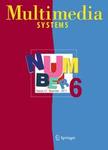版权所有:内蒙古大学图书馆 技术提供:维普资讯• 智图
内蒙古自治区呼和浩特市赛罕区大学西街235号 邮编: 010021

作者机构:Chalmers Univ Technol Dept Signals & Syst S-41296 Gothenburg Sweden
出 版 物:《MULTIMEDIA SYSTEMS》 (多媒体系统)
年 卷 期:2006年第11卷第5期
页 面:468-479页
核心收录:
学科分类:08[工学] 0812[工学-计算机科学与技术(可授工学、理学学位)]
主 题:packet loss prediction Bayes estimation IP network modeling packet delay network-adaptive video coding
摘 要:Designing good network-adaptive, error resilient video coders for IP networks is a challenging task. Video data packets can be lost as a consequence of congestion in the network, causing a degradation in video quality at the receiver side. Predicting the packet loss probability is therefore an important step in the design of an efficient network-adaptive video coder. In this paper, we present a novel Bayesian-based approach that can dynamically predict the instantaneous packet loss probability as well as estimate the probability distribution of the cross-traffic rate. The method utilises observed losses and end-to-end measurements of the packet delays to predict the time-varying cross-traffic rate in the network. The posterior probability for the cross-traffic rate is established by using the Bayes formulation. To obtain this, the probability of delays conditioned on the cross-traffic are derived by decomposing the delays with a multi-scale wavelet transform. The probability of the observed losses conditioned on the cross-traffic are derived by studying the queueing properties in the network. The predicted packet loss probability is then derived from the posteriori distribution of the cross-traffic rate and the expected queueing behaviour. An algorithm for obtaining the numerical solution is also given. Two sets of simulations are performed to demonstrate the effectiveness of the proposed method. The first set is designed to test the performance of the proposed Bayesian method for dynamically predicting the packet loss probabilities. The results of the predicted packet loss probabilities are then compared with the ground truth of packet loss values for three different network traffic generators. In the 2nd set of simulations, the proposed method and the two-state Markov model are incorporated separately into a network-adaptive video codec whose coding rate is adapted to the predicted packet loss probabilities. The reconstructed videos using these two methods are the